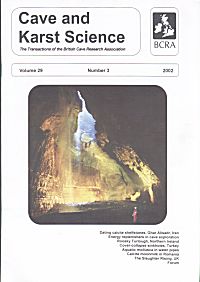
BCRA > Publications > Cave & Karst Science> Contents
Scroll down for Editorial | Papers | Reports | Forum | Thesis Abstracts
 |
Cover photo by Jeff Cowling during the Craven Pothole Club winch meet, August 2002: Gaping Gill Main Chamber and the base of Gaping Gill's Main and Lateral shafts, viewed from the far west slope. The depth of the Main Shaft, first descended by Edouard Alfred Martel in 1895 (see Cave and Karst Science 26(1)) is the subject of ongoing discussion in this Issue's Forum. |
This page created by Dr John D. Wilcock